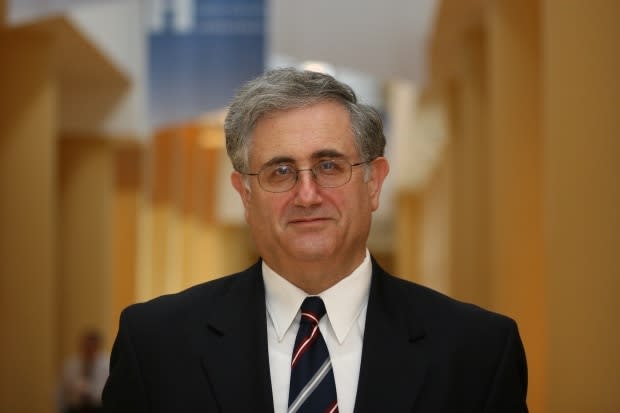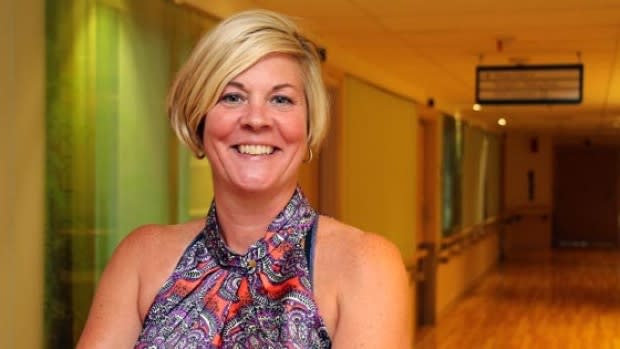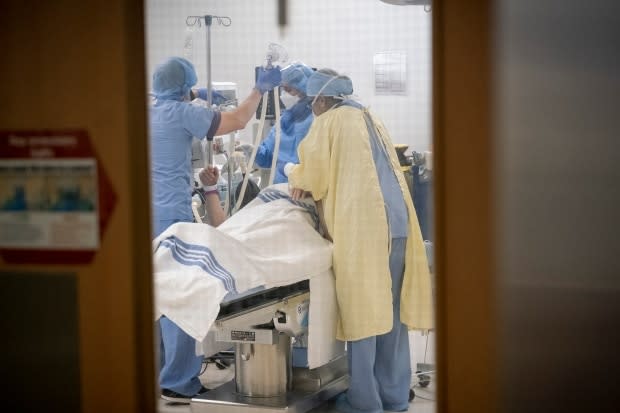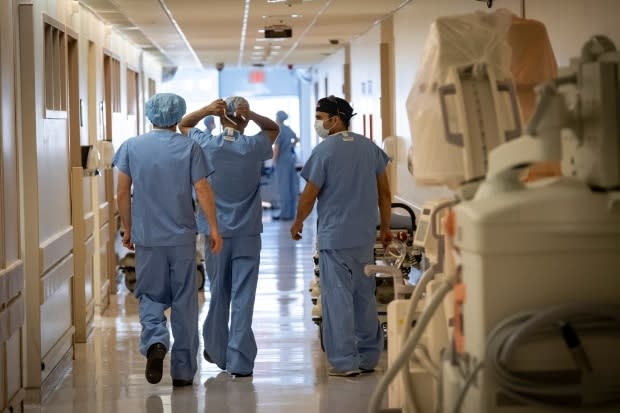How surgical smoothing could help ease the medical backlog created by COVID-19
Tony Delitala has a ticking time bomb in his throat. Doctors discovered it right before the pandemic hit, in the form of a nodule growing on his thyroid.
"[They] found it was papillary carcinoma, which seemed to be contained in that area. So with a quick 45-minute surgery and a quick six-centimetre incision, it would be out and I would be home that night."
Delitala was supposed to go under the knife on July 2. The 60-year-old graphic designer from Grand Bend, Ont., volunteered to take any earlier cancellations and got one. His procedure was moved up to June 18, but then it was bumped to August 13 before being cancelled altogether on Wednesday.
"The joy you felt with getting bumped forward was juxtaposed to the disappointment we felt when we saw it was going to be bumped back to August 13."
"Yesterday, when I went to do some pre-op stuff they told me it was bumped again and they didn't give me a date. The doctor said 'As long as we get thing out in the next year we'll be fine,' but a year with this? I'm not too happy about it."
COVID delayed an estimated 100,000 surgeries

Delitala's cancelled surgery is among the estimated backlog of 100,000 elective procedures that have been delayed because of the pandemic – procedures that range from cataract removals to knee replacements, cardiac procedures and transplants – all medically necessary and often critical operations that could make real differences in peoples' lives.
The Ministry of Health said there is no timeline for when these procedures will resume and that it is up to regional medical officials to decide when elective surgeries will start being performed.
It means there's no universal solution to how Ontario's network of 147 hospitals will deal with problem, but a new approach to surgery pioneered in Canada by a Toronto hospital could hold the key to helping more people faster as the province deals with a huge backlog of elective cases created by the coronavirus crisis.
It's called surgical smoothing and it was pioneered in Canada by Toronto's UHN in conjunction with the Boston-based Institute for Hospital Optimization (IHO) at Harvard University.
What is surgical smoothing?

Most scheduled surgeries happen between 8 a.m. and 5 p.m. Monday to Thursday, according to Eugene Litvak, the president and CEO of the IHO and a go-to guru on hospital efficiency in North America.
"Surgeons schedule things for when they want time off," he said. "Urgent surgeries you cannot control."
Because of these two conflicting variables, patient volumes go up and down like the stockmarket. In fact, if you were to chart the flow of patients through a typical hospital, which Litvak has, it would look something like a printout from seismograph. Sharp inclines as patients are admitted are followed by dips and valleys as patients are treated and released.
The idea behind surgical smoothing is to keep the line as flat as possible, to avoid potential overcrowding and potential mistakes by harried medical staff who are up to their necks in cases.
The problem though, is those competing variables. As Litvak described, surgeons typically schedule elective operations at their convenience, whereas emergencies don't respect schedules. A hospital can't predict what will happen on any given day along with the injuries, car accidents and heart attacks that show up unannounced and need to be dealt with immediately.
Creating separate surgical streams

Most hospitals perform emergency and scheduled surgeries out of the same operating rooms, which means a patient due for a scheduled knee replacement might get bumped at the last minute by a ruptured appendix, or the victim of a bad industrial accident.
Surgical smoothing eliminates the competing variables of urgent and elective surgery by separating them into two distinct streams, Litvak said.
"We ask them to separate scheduled and unscheduled surgeries, to perform them in different operating rooms by a team that would not be doing elective surgeries, so they don't create conflicts.
"The main reason why is, what is the ideal scenario for elective surgeries? You schedule them back-to-back like sardines in a can. Then you can do more surgeries.
"If you combine them with urgent surgeries that would mean excessive time for urgent surgeries because all the operating room will be occupied by electives. You can't stop an operation. The ideal scenario would be to have empty operating rooms so whatever comes, you can treat. That's the reason why they should be separated," he said.
It sounds simple enough, but UHN goes another step beyond that. The hospital had its doctors design their own urgency classification system, one that was more detailed and nuanced than the province's standard of the four-tiered triage system.
When hospitals deal with urgent cases, they work on a sliding scale with four categories. The most urgent level involves immediate cases where the patient is dying and needs resuscitation
Adding granularity to Ontario's generic triage system

It took some debate, but eventually the hospital came to a consensus, according to Terri Stuart-McEwan, UHN's executive director of surgery administration, who oversees 34 ORs at three Toronto hospitals.
She said UHN just happened to have developed its enhanced urgency classification system about a year before the pandemic hit, so the hospital was able to use its new tool to ramp down operations once Toronto became awash in COVID-19 cases.
"If it's full of COVID, you can't rob Peter to pay Paul," she said. "We took what was four levels and turned it into nine and it gave a lot more granularity to our triage."
This nine-tiered triage, much like the province's four-tiered scale, went from immediate to non-urgent, but with each tier it had a correlated number of resources attached to it, in terms of time, beds and staff, allowing much greater nuance and flexibility when it came to managing current and anticipated demand on hospital resources.
"We actually did this at such a granularity that in the middle of the pandemic we would sit there and, by using the IHO methodology, we were able to create a booking form that said 'I need one bed for three days,' 'I need this amount of resource,' and we were able to match it in what we call a daily smoothing target. Literally to say, 'kay, we only have five beds, who's going to take the five beds? And let's make sure it's smooth.
"It served so well to be able to ramp down and equally to ramp up."
UHN found going from four levels to nine dramatically improved their ability to manage resources and eliminate waste. The provincial requirements were simply too broad and clumsy.
"We've embraced this even going forward in our pandemic recovery, so what were saying every day to all of our surgeons is 'Submit your surgeries, but you have to smooth." Stuart-McEwan said.
"We now have a macro and micro level of the resources they require so that we can now plan so they don't overuse ICU beds and PPE."
Unprecedented sophistication in resource management

It meant the hospital was one of the first in the province to curtail its non-essential services in a well-coordinated way. Equally, UHN was one of the first in the province to resume elective procedures on June 5, even though its hospitals took the bulk of Ontario's serious coronavirus cases.
By comparison, most hospitals in the province have only started their electives recently.
Stuart-McEwan said once implemented, the system was able to give UHN the unprecedented ability to predict down to the bed how many resources it had and where they could be used most efficiently, allowing doctors to treat or defer the right number of cases based on priority.
"We were controlling the valve at such a precise measure and we were able to get this amazing opportunity to have them tell us okay, who do you really need to treat, who are you really worried about?"
In fact, the scale of sophistication in UHN's response to the pandemic put it in a class of its own during the pandemic, according to Litvak, who regularly consults with top hospitals in Canada and the US.
"When the COVID epidemic started they were in a much better position than any other hospital I know, whether it's in the US or Canada.
"For example, they know the COVID demand and they were told by the hospital 'Guys, you may have that many operating room times tomorrow and that many beds.' Now, they can see. Can we take care of only the third most urgent group? Or the first three or the first two? Because they know how many beds and resources they would need.
"They have a clear link between the urgency level and the capacity needed to do it," he said.
Surgical smoothing could be used across Ontario

If applied on a broader scale, surgical smoothing could go far to pare down the estimated 100,000 surgeries that were delayed by the pandemic and could make a real difference in people's lives.
Stuart-McEwan said the beauty of surgical smoothing is, once established, it can be used anywhere.
"I totally believe all this is totally translatable to any organization, it's just really having your organization understand where your resources need to be and how to allocate them and the efficient and effective use of it," he said.
"This has been an 18-month journey for us and I'm not naive enough to think it's done but I think it's imminently translatable."
The province has known about this system since 2016 but has yet to roll it out.
Litvak said he was hired by Ontario's auditor general four years ago to look at waste in the healthcare sector and he recommended surgical smoothing to create a more efficient health system.
"Nothing practical has been implemented," he said, noting the only reason UHN has put the system in place is because the hospital independently approached the IHO in 2018 to make better use of its resources.
Ontario has struggled for years with an overburdened healthcare system, where wait times are long, patients outnumber beds and people are regularly placed in meetings rooms and hallways because wards are full.
Litvak said with surgical smoothing, hospitals would be able to better manage their resources, which would result in less waste, fewer medical mistakes and like UHN in Toronto, would put all of Ontario's hospitals in a better position for when the pandemic heats up again.
"They're prepared for a potential, god forbid, second wave and they are maximally utilizing their beds and they are dramatically improving the quality of their care."


